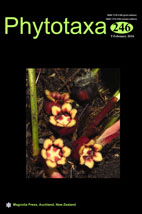Abstract
The genus Berkheya is paraphyletic with the related genera Cullumia, Cuspidia, Didelta and Heterorhachis embedded within a broader clade termed the ‘Berkheya clade’. As a contribution towards reassessment of species relationships and delimitation of species groupings within the clade, the utility of external achene morphology for supporting natural species groups within the clade was evaluated. Achenes from 67 species and 10 infraspecific taxa were examined, including representatives of each genus currently recognised in the Berkheya clade. Achene pubescence and pappus characteristics (e.g., scale shape and number of scales within a series) were indicated to be particularly variable and thus less reliable for assessment of species relationships. Of the currently recognised genera, only segregation of Cullumia was supported by achene and pappus characteristics. Species groupings implicit in Roessler’s infrageneric classification of eight series within Berkheya were to a large extent supported. However, in particular, series Speciosae was indicated to be a disparate species grouping and the distinction of series Angustae and Cruciatae is not supported by achene and pappus morphology. Achene and pappus characteristics suggest several novel species groupings (e.g. an affinity between Berkheya cuneata, B. ferox and B. spinosa). Although the taxonomic sampling in published molecular phylogenetic analyses is limited, achene and pappus morphology partially supports clades resolved in prevailing phylogenetic reconstructions for the clade. More complete sampling in future molecular phylogenetic analyses is required to test novel species affinities suggested in the present study and to explore the evolution of the achene and pappus in the Berkheya clade.

